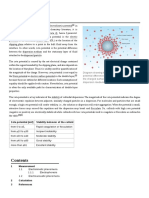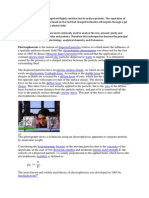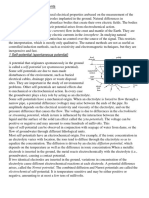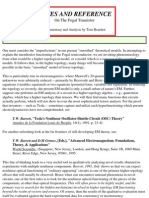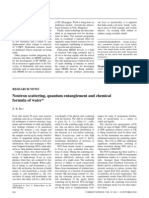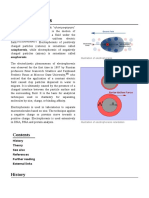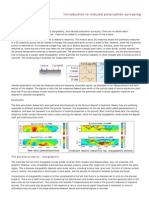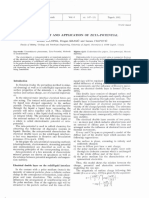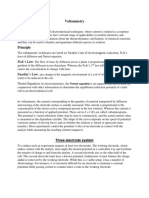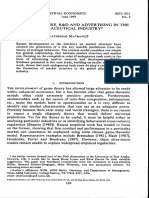Zeta Potential: A New Approach
Zeta Potential: A New Approach
Uploaded by
elektron2010Copyright:
Available Formats
Zeta Potential: A New Approach
Zeta Potential: A New Approach
Uploaded by
elektron2010Original Title
Copyright
Available Formats
Share this document
Did you find this document useful?
Is this content inappropriate?
Copyright:
Available Formats
Zeta Potential: A New Approach
Zeta Potential: A New Approach
Uploaded by
elektron2010Copyright:
Available Formats
Zeta Potential: A New Approach
by
Bruce B. Weiner, Walther W. Tscharnuter, David Fairhurst
Brookhaven Instruments Corporation Holtsville, NY 11742 US
A paper presented at the Canadian Mineral Analysts Meeting,
September 8-12, 1993 held in Winnipeg, Manitoba, Canada.
Bruce B. Weiner, Walther W. Tscharnuter, David
Fairhurst Brookhaven Instruments Corporation, Holtsville,
NY 11742
The zeta potential (ZP) is a function of the surface charge which develops when any material is placed
in a liquid. It is a very good index of the magnitude of the electrostatic repulsive interaction between
particles. The ZP is commonly used to predict and control dispersion stability. The characteristics of
the solid-liquid interface may also influence, inter alia, adhesion, flotation and, in more concentrated
systems, rheological behavior. Reliable ZP determinations are thus of practical concern to may
industries including ceramics preparation, processing and application.
A group of phenomena, known collectively as Electrokinetic Effects, can be exploited as the basis for
determining the zeta potential (ZP). The most widely studied, and of most practical relevance to
colloidal-sized paniculate suspensions, is particle electrophoresis, or microelectrophoresis, the
movement of charged particles suspended in a liquid under the influence of an applied electric field.
This offers the possibility of measuring the complete mobility spectrum. Over the past decade, the
technique of Electrophoretic Light Scattering (ELS) has been used extensively to characterize the ZP of
colloidal sized particles. ELS measurements are many times faster than conventional manual
techniques. Although the basic ELS illuminating optics and signal processing appear deceptively
simple, in practice, careful optimization is needed to obtain usable signals. Aside from the optical
problems in either the cross beam or the reference beam configurations, an inherent limitation to obtain
precise and repeatable results is the electro-osmotic effect, which up to now could only be accounted
for by careful and time consuming scans across the sample cell.
The transformation from electrophoretic mobility to ZP is not a trivial matter; the assumption of a
simple, constant, relationship (commonly the Smoluchowski limit of the Henry equation) is not
generally applicable. Of prime importance is the need to know the particle size, which can be
determined rapidly by Dynamic Light Scattering (DLS) using a newly developed single board real time
correlator with a dynamic range exceeding 10 decades.
The present paper will address these questions and discuss recent advances in instrument design to
reduce or even eliminate (in the important case of electro-osmosis) the various instrument limitations.
The importance of the ZP to ceramic processes, and the factors which effect the magnitude of the ZP,
are illustrated using examples from measurements of various oxides and non-oxides commonly used in
ceramics formulations.
Attraction of colloidal particles is fundamental. It arises from a variety of dispersion forces, and it is a
relatively long range force. The energy of attraction varies as 1/r
2
, where r is the distance between
particles. All colloidal dispersions will eventually aggregate unless there are sufficient forces to
prevent adherence of particles. For particles in water or other polar liquids, the most common force
of repulsion arises from charges on the particles.
As a result of the charge at the surface of the particle in the liquid an electrical double layer is formed.
One part of the layer consists of the charges on the particle's surface. The other is the increased
concentration of counterions near the surface and the corresponding decrease of coions. These changes
of ion concentrations near the surface decrease further from the surface due to the thermally driven
motion of ions
ELECTROKINETIC PHENOMENA
ARISES WHEN TWO PHASES MOVE WITH RESPECT TO EACH OTHER
WITH AN ELECTRIC DOUBLE LAYER AT THE INTERFACE
FOUR RELATED PHENOMENA:
ALL INVOLVE RELATIVE MOVEMENT BETWEEN RIGID AND MOBILE
PARTS OF THE DOUBLE LAYER
CHARGE SURFACE. IONS -------------
-------------------- AND SOLVENT
1. ELECTROPHORESiS
MOVEMENT OF CHARGED SURFACE STATIONARY
LIQUID APPLIED ELECTRIC FIELD
2. ELECTRO-OSMOSIS
MOVEMENT OF LIQUID STATIONARY CHARGED
SURFACE APPLIED ELECTRIC FIELD
(i.e., the complement of electrophoresis)
3. STREAMING POTENTIAL
MEASURED ELECTRICAL FIELD MOVEMENT OF LIQUID
- MECHANICAL STATIONARY CHARGED SURFACE (i.e.,
the opposite of electro-osmosis)
4. SEDIMENTATION POTENTIAL
MEASURED ELECTRICAL FIELD MOVEMENT OF
CHARGED PARTICLES STATIONARY LIQUID
(i.e., the opposite of electrophoresis)
When charged electrodes are placed in a suspension of charged particles, the particles move toward the
electrode of opposite charge. The simplest arrangement for observing the movement is a Van Gils cell.
The electrophoretic velocity is proportional to the electric field, with the proportionality constant
called the electrophoretic mobility.
ELECTROPHORETIC MOBILITY
Zeta potential is proportional to the electrophoretic mobility, at least in the simplest case. Zeta
potential is the parameter which determines the strength of the repulsion between particles. As
such, it is this quantity, not mobility, that is important.
ZETA POTENTIAL
In the Van Gils' cell, and all other commercially available cells, except one, the electric field lines cut
across the charged walls of the cell. Electroosmotic movement of the liquid occurs. In a closed cell
this forces a flow in the cell that results in two, equal counterflow patterns. The measured velocity of
particles anywhere in the cell is the sum of the electroosmotic and electrophoretic velocities. The
electroosmotic velocity is zero at two special planes, called stationary planes, in the cell. If the
velocity is measured at these special positions, it is equal to the desired electrophoretic velocity
The stationary planes are very close to the cell walls. Unfortunately, electroosmotic velocity changes
most rapidly around the stationary planes. The depth of field of most optical systems is large enough
that averaging occurs. Thus, it is difficult to ignore the effect on the measured velocity of the
electroosmotic part
For accurate measurements it is necessary to verify, each time, the positions of the stationary planes (also
called stationary levels). Prof. Bob Pelton at the Univeristy of Toronto has shown that large errors ensue
if the levels are not verified.
Due to the rapid change around the stationary planes of the electroosmotic velocity, it is particularly
difficult to measure an accurate width of the electrophoretic mobility distribution. The distribution width
is an indication of the distribution of zeta potential. It is an important parameter for determining the long-
term stability of the dispersion.
Theory shows that the observed velocity distribution across the cell is parabolic, except in the case
of very low mobility. In this special case, near the walls, the velocity may change direction. In any
case, where electroosmosis exists, it is essential, for accurate measurements, to measure at several
positions across the cell. The data are then fit to a parabola. If the fit is good, then the average
electrophoretic velocity, at the stationary planes can be determined by interpolation.
In recent years the technique of Electrophoretic Light Scattering (ELS) has been applied to the
measurement of the velocity of charged particles in a liquid. This has the advantage of measuring a
large number of particles simultaneously without the subjective and time-consuming character
imposed by classical, visual observation. Unfortunately, all commercially available instruments,
except the ZetaPlus, a new instrument, also suffer from the problem of electroosmosis. In an ELS
instrument a focused beam of laser light passes through the cell. A part of the laser beam is diverted
before it reaches the cell. This beam is combined with the scattered light. This beam is variously
called the reference beam or local oscillator. Its purpose, as shown later, is to determine the sign of
the charge on the particle, and, hence, the sign of the zeta potential.
In the ZetaPlus the electrodes are entirely within the cell. The electric field does not cut across the
cell walls. As a result no electroosmosis occurs, and the velocity measured between the electrodes is
only due to electrophoresis. There is no electroosmotic effect, nor any stationary planes to verify.
A large number of advantages arise as a result of using this configuration.
Since there are no standards to which any particle electrophoresis measurements can be compared, it is
only possible to compare different techniques. Here the electrophoretic mobility of TiO, is compared
as a function of pH using a classical Van Gils' cell ( Rank Mk II instrument) with visual
measurements and the ZetaPlus cell with ELS measurements. The agreement is excellent, indicating
the essential accuracy of the new design. It is worthwhile pointing out that each point plotted using
the Van Gils' cell is the result of interpolation at the stationary plane after measurements across the
cell were made. Such measurements take a long time. In contrast the ELS measurements are much
faster, and no interpolation is required.
Measurement of the Zeta Potential of Degussa P25 Titaniom Oxide in
aqueous suspension: Comparison of the BI-ZetaPlus and the Rank Mk II
When particles move perpendicular to the laser beam the frequency of the scattered light is shifted. This
Doppler shifted frequency contains the information on the electrophoretic mobility. Since frequency is
inherently a positive quantity, it is necesssary to add a local oscillator (reference beam) in order to
separate positive and negative shifts. Doppler shifts greater than the frequency of the local oscillator arise
from positively charged particles. Doppler shifts less than the frequency of the local oscillator arise from
negatively charged particles. The local oscillator frequency in the ZetaPlus is 250 Hz. Doppler shifts are
generally less than 100 Hz
The measured Doppler shift frequency is proportional to the electrophoretic velocity, the proportionality
constant is a well-known function of laser wavelength, liquid refractive index, and scattering angle.
In addition to motion of the particle due to electrophoresis, Brownian motion is also important. The
resulting diffusion of the particles broadens the measured mobility distribution.
The diffusional broadening is inversely proportional to particle size and is a strong function of scattering
angle: the smaller the angle, the less the diffusional broadening. In the ZetaPlus the scattering angle is
only 15.
Zeta potential is a parameter that characterizes the stability of an electrostatically stabilized
dispersion.
Although zeta potential is not a direct measure of surface charge densitymost surfaces are too
complicated for such a direct proportionality to existit changes when the surface charge changes. Any
added species which changes the surface charge will cause some change in the zeta potential. A common
example occurs when the pH is changed in dispersions of oxides or other surfaces that are either acidic or
basic. The pH at which the zeta potential is zero is called the isoelectric point (I.E.P.). At this pH the
repulsive forces are zero, and aggregation will occur.
Such a list, while instructive, can be misleading. The zeta potential is determined by the surface
chemistry. Even a small percent of a component, if preferentially adsorbed at the surface of the
particle, will largely determine the surface charge density, the resulting zeta potential, and the
stability, or lack thereof, of the dispersion. In the following examples, a commercially available TiO
2
sample, one sold as pure titanium dioxide, acts like either alumina or silica depending on which of
these components is at the surface. The lesson is this. It is not the bulk properties of the material
which determine stability; it is the surface properties.
Since small changes in surface chemistry have a large effect on dispersion stability, it is also a
mistake to assume that batch-to-batch and lot-to-lot variations in will not affect dispersion. In the
example shown here the I.E.P. varies by nearly two pH units, and this was the same bulk material
from the same supplier tested over a five year period. It is not possible to measure zeta potential
once, or rely on average properties found in the literature. It is necessary to make measurements on
a continuing basis
You might also like
- Theory of The Streaming Current MonitorDocument10 pagesTheory of The Streaming Current MonitorMirza Quanta Ahady HusainiyNo ratings yet
- Zeta PotentialDocument4 pagesZeta PotentialChemPetroNo ratings yet
- Zeta Potential - Wikipedia, The Free EncyclopediaDocument4 pagesZeta Potential - Wikipedia, The Free EncyclopediaAni KumarNo ratings yet
- Measurement and Application of Zeta PotentialDocument5 pagesMeasurement and Application of Zeta PotentialSiêu Nhân Kem XôiNo ratings yet
- Electrophoresis Is The Motion ofDocument3 pagesElectrophoresis Is The Motion oflittlemuaNo ratings yet
- ElectrophoresisDocument25 pagesElectrophoresisZaki SyedNo ratings yet
- Amr Adel GeophysicsDocument15 pagesAmr Adel GeophysicsTamer Hesham AhmedNo ratings yet
- Electrophoresis - WikipediaDocument7 pagesElectrophoresis - WikipediaVikram DasNo ratings yet
- Single Electron Transistor: Our World Is Without Doubt Built On The Power of The Transistor, A Microscopic ElectronicDocument6 pagesSingle Electron Transistor: Our World Is Without Doubt Built On The Power of The Transistor, A Microscopic ElectronicLily SharmaNo ratings yet
- Brief Study of Cyclic Volt Am Me TryDocument13 pagesBrief Study of Cyclic Volt Am Me Tryawaiskhan05174No ratings yet
- PhysRevA.80.043626Document17 pagesPhysRevA.80.043626Pradosh BasuNo ratings yet
- Bearden - Tech Papers - Fogal Transistor Notes and ReferenceDocument29 pagesBearden - Tech Papers - Fogal Transistor Notes and Referencelightingfastno808No ratings yet
- Neutron Scattering, Quantum Entanglement and Chemical Formula of WaterDocument3 pagesNeutron Scattering, Quantum Entanglement and Chemical Formula of WaterYosi MosheNo ratings yet
- Electrochemistry: Dr. G. Purna Chandra RaoDocument29 pagesElectrochemistry: Dr. G. Purna Chandra RaosreekanthsharmaNo ratings yet
- Zeta Potential AnalysisDocument3 pagesZeta Potential AnalysisBill HunterNo ratings yet
- Electrophoresis: Electrophoresis (from the Greek "ηλεκτροφόρηση"Document5 pagesElectrophoresis: Electrophoresis (from the Greek "ηλεκτροφόρηση"James FranklinNo ratings yet
- Electroacoustic phenomena - WikipediaDocument5 pagesElectroacoustic phenomena - WikipediagireeshplyNo ratings yet
- APL FraboniDocument3 pagesAPL FrabonikanchankonwarNo ratings yet
- FemtoElectrochemistry TongDocument8 pagesFemtoElectrochemistry TongYujinNo ratings yet
- Energy & Environmental Science: CommunicationDocument6 pagesEnergy & Environmental Science: CommunicationBhabani Sankar SwainNo ratings yet
- Chapter 6-Introduction To NanoelectronicsDocument83 pagesChapter 6-Introduction To NanoelectronicsshobiiiscNo ratings yet
- Capillary Electrophoresis: S. F. Y. Li and Y. S. Wu, National University ofDocument12 pagesCapillary Electrophoresis: S. F. Y. Li and Y. S. Wu, National University ofskljoleNo ratings yet
- ExcitonDocument10 pagesExcitonAnish KumarNo ratings yet
- APEX MD MechElectrDocument4 pagesAPEX MD MechElectrJosh LansiganNo ratings yet
- ElectrophoresisDocument12 pagesElectrophoresisbensiworkprofileNo ratings yet
- Electron MobilityDocument17 pagesElectron MobilityKennyxueNo ratings yet
- Flex o ElectricDocument37 pagesFlex o ElectricMani PrakashNo ratings yet
- Alpha 7Document2 pagesAlpha 7irenellemedallaNo ratings yet
- Introduction To Induced Polarization SurveyingDocument17 pagesIntroduction To Induced Polarization Surveyingrojara2008100% (1)
- Aerospace: Modeling Plasma Via Electron Impact IonizationDocument25 pagesAerospace: Modeling Plasma Via Electron Impact IonizationProjesh BasuNo ratings yet
- 〈432〉 Determination of Zeta Potential by Electrophoretic Light ScatteringDocument5 pages〈432〉 Determination of Zeta Potential by Electrophoretic Light ScatteringAvijit HazraNo ratings yet
- Low Energy Ion ScatteringDocument13 pagesLow Energy Ion ScatteringjassssssuNo ratings yet
- A Method To Separate Process ContributionsDocument6 pagesA Method To Separate Process ContributionspepeNo ratings yet
- Hall Effect in A Moving LiquidDocument14 pagesHall Effect in A Moving LiquidSiddhant SharmaNo ratings yet
- A Coupled Electro-Hydrodynamic Numerical Modeling of Droplet Actuation by ElectrowettingDocument8 pagesA Coupled Electro-Hydrodynamic Numerical Modeling of Droplet Actuation by Electrowettingmypassion59No ratings yet
- Zeta PotentialDocument17 pagesZeta PotentialMadhu JNo ratings yet
- Bearden - Tech Papers - Fogal Transistor Notes and Reference PDFDocument29 pagesBearden - Tech Papers - Fogal Transistor Notes and Reference PDFUn Chubacca Yeti100% (1)
- Induced Polarisation ThesisDocument8 pagesInduced Polarisation Thesistjgyhvjef100% (1)
- A Case for Electron-Astrophysics - Bruno Et Alii - 2021Document48 pagesA Case for Electron-Astrophysics - Bruno Et Alii - 2021Simone SuardiNo ratings yet
- Optical Manipulation of Nanoparticles: A Review: Maria Dienerowitz, Michael Mazilu, and Kishan DholakiaDocument32 pagesOptical Manipulation of Nanoparticles: A Review: Maria Dienerowitz, Michael Mazilu, and Kishan DholakiaZakir AhmedNo ratings yet
- E-Hole Pair GbhieherationDocument9 pagesE-Hole Pair GbhieherationTushar Dhabal DasNo ratings yet
- Capillary ElectrophoresisDocument9 pagesCapillary Electrophoresisrani mehraNo ratings yet
- Measurement and Application of Zeta-Potential: Branko SALOPEK, Dragan and Suzana FILIPOVIDocument5 pagesMeasurement and Application of Zeta-Potential: Branko SALOPEK, Dragan and Suzana FILIPOVIAmber ClarkNo ratings yet
- Molecular Scale ElectronicsDocument49 pagesMolecular Scale ElectronicspraveenNo ratings yet
- Measurement and Application of Zeta-Potential: Branko SALOPEK, Dragan and Suzana FILIPOVIDocument5 pagesMeasurement and Application of Zeta-Potential: Branko SALOPEK, Dragan and Suzana FILIPOVIgusuchihaNo ratings yet
- Electron TheoryDocument13 pagesElectron TheoryAilene Tsui Alferez PaciaNo ratings yet
- Atoms Solids Crystalline:) Transmission Electron MicroscopeDocument6 pagesAtoms Solids Crystalline:) Transmission Electron MicroscopeAtul DwivediNo ratings yet
- PH-155 Measurement of Ge Bandgap Using Ge Thin Film Using Four Probe MethodDocument6 pagesPH-155 Measurement of Ge Bandgap Using Ge Thin Film Using Four Probe MethodAmit RajNo ratings yet
- 76.JApplPhys 107 084503 PDFDocument9 pages76.JApplPhys 107 084503 PDFAjayaKumarKavalaNo ratings yet
- Bending Instability of Electrically Charged Liquid Jets of PolymeDocument19 pagesBending Instability of Electrically Charged Liquid Jets of PolymeyessicaNo ratings yet
- Understanding ElectrochemistryDocument3 pagesUnderstanding ElectrochemistryMarisol GómezNo ratings yet
- Voltammetry: Fick's LawDocument5 pagesVoltammetry: Fick's LawMuhammad ArsalanNo ratings yet
- PhysicalChemistry 6th Sem - Pastpaper SQs Solved (Complete) by Haseeb AhmadDocument31 pagesPhysicalChemistry 6th Sem - Pastpaper SQs Solved (Complete) by Haseeb AhmadMuhammad UsmanNo ratings yet
- Channel Electrodes - A ReviewDocument24 pagesChannel Electrodes - A ReviewSanjip Kumar SapkotaNo ratings yet
- Yue 2021Document10 pagesYue 2021toonNo ratings yet
- Relaxation and Edge Reconstruction in Integer Quantum Hall SystemsDocument15 pagesRelaxation and Edge Reconstruction in Integer Quantum Hall SystemsDustisNo ratings yet
- Zalka-Péter2020 Article OnTheEvolutionAndApplicationOfDocument8 pagesZalka-Péter2020 Article OnTheEvolutionAndApplicationOfbsynjoinNo ratings yet
- Electrospinning Distribution of Charges in Liquid JetsDocument6 pagesElectrospinning Distribution of Charges in Liquid Jetsxiaobing DongNo ratings yet
- Future Journal of Pharmaceutical SciencesDocument13 pagesFuture Journal of Pharmaceutical Scienceselektron2010No ratings yet
- MGDocument12 pagesMGelektron2010No ratings yet
- Car Box I Metil CelulosaDocument30 pagesCar Box I Metil Celulosaelektron2010No ratings yet
- Sindrome LumbociaticoDocument23 pagesSindrome Lumbociaticoelektron2010No ratings yet
- 1-7 Manufacturing BasicsDocument29 pages1-7 Manufacturing Basicselektron2010No ratings yet
- T S P and PceduresDocument5 pagesT S P and Pcedureselektron2010No ratings yet
- Dgradcn Aaia AgiosDocument3 pagesDgradcn Aaia Agioselektron2010No ratings yet
- 0777 Ondrugdelivery Oral Drug Delivery July 2012 Low ResDocument24 pages0777 Ondrugdelivery Oral Drug Delivery July 2012 Low Reselektron2010No ratings yet
- Napr InterDocument8 pagesNapr Interelektron2010No ratings yet
- Testing Sieves Principles and Procedures PDFDocument24 pagesTesting Sieves Principles and Procedures PDFelektron2010No ratings yet
- Suon Lacn SteaDocument10 pagesSuon Lacn Steaelektron2010No ratings yet
- Market Structure, R&D and Advertising in The Pharmaceutical IndustryDocument27 pagesMarket Structure, R&D and Advertising in The Pharmaceutical Industryelektron2010No ratings yet
- A New Look at The Returns and Risks To Pharmaceutical R&DDocument19 pagesA New Look at The Returns and Risks To Pharmaceutical R&Delektron2010No ratings yet

